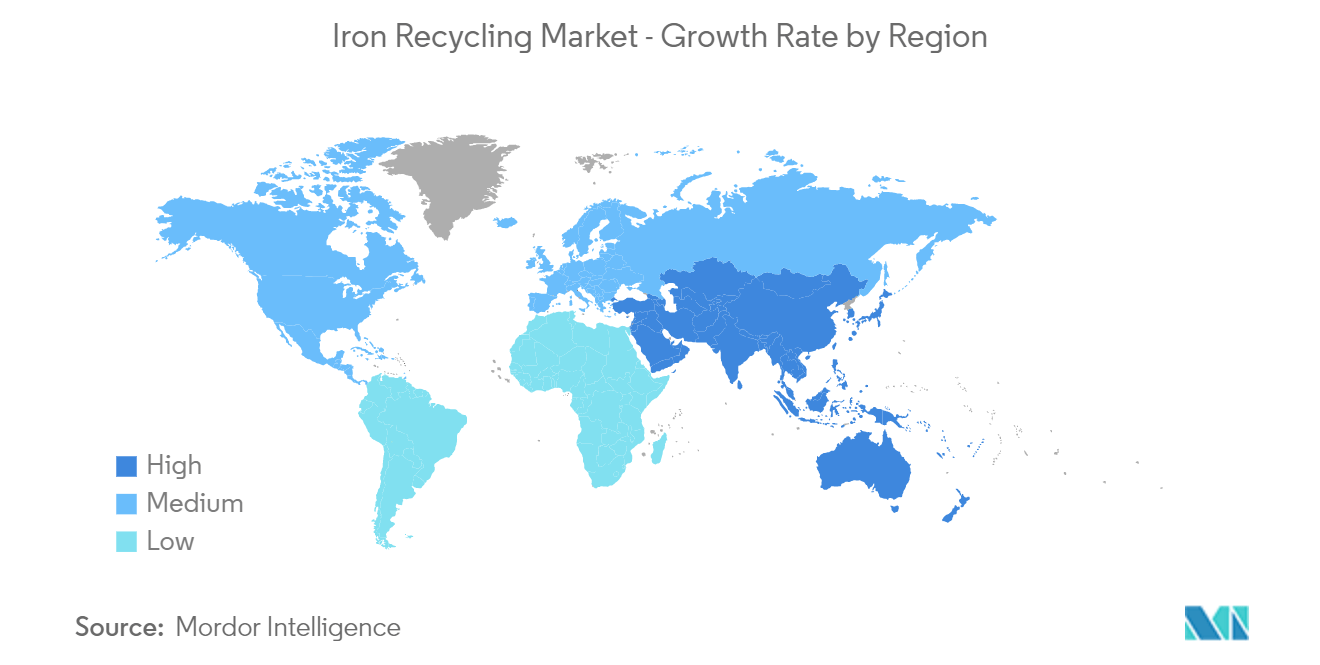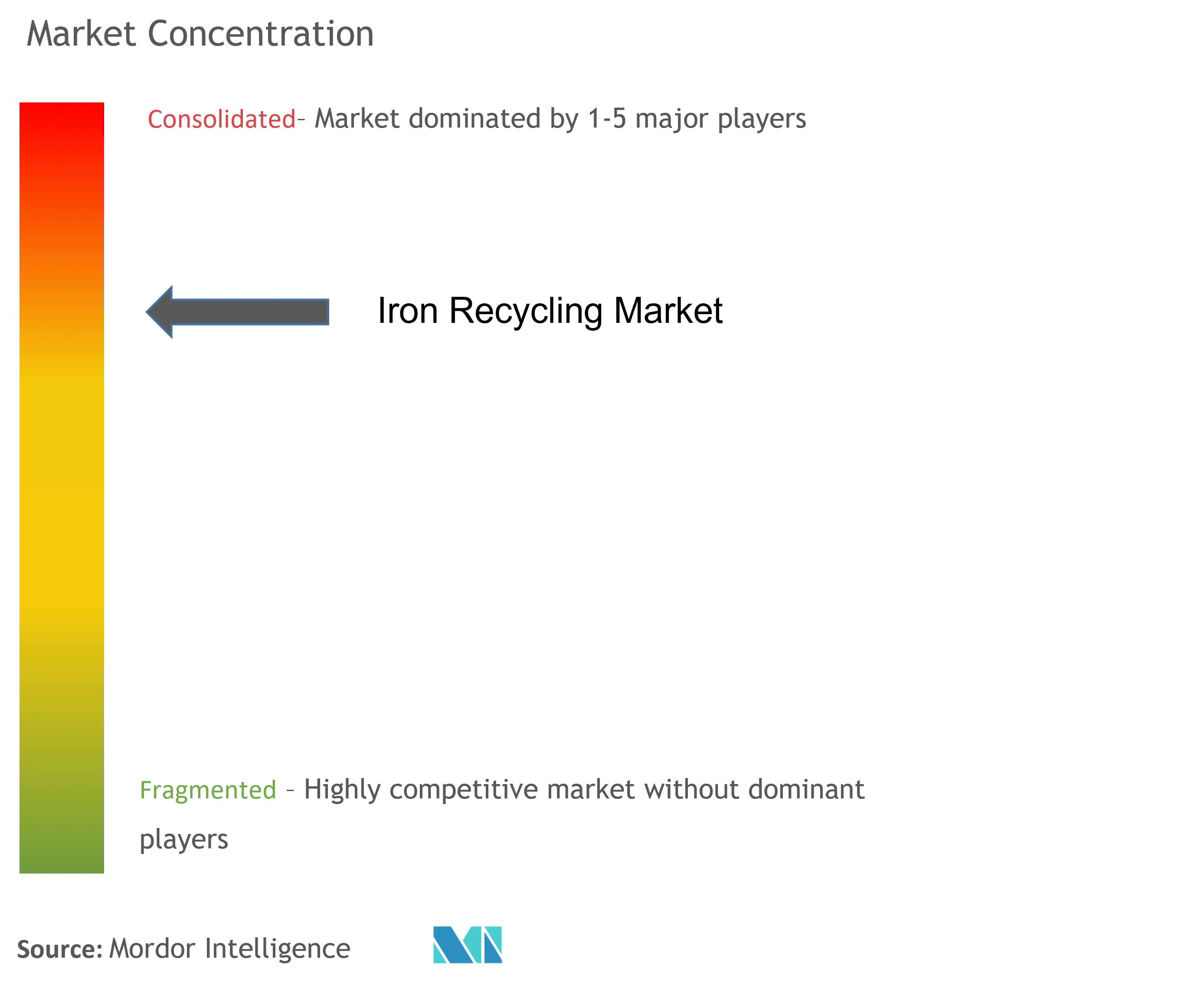Iron Recycling Market Size and Share

Iron Recycling Market Analysis by Mordor Intelligence
The Iron Recycling Market is expected to register a CAGR of greater than 7% during the forecast period.
The market was negatively impacted by COVID-19 in 2020. During the pandemic scenario, the construction and automotive manufacturing activities were on a temporary halt during the lockdown to curb the spread of new COVID-19 cases, thereby, decreasing the consumption of recycled iron from these end-user industries. However, the condition recovered in 2021, which is expected to benefit the market during the forecast period.
- Over the short term, an increase in urbanization and industrialization is expected to drive the market's growth.
- On the flip side, the unorganized flow of waste metals tends to act as a restraint on the growth of the market.
- Stringent regulations imposed by the government regarding metal mining act as an opportunity for the growth of the market in the near future.
- Asia-Pacific dominated the market globally, with the largest consumption from construction activities in countries such as India, China, and others.
Global Iron Recycling Market Trends and Insights
Building and Construction to Dominate the Market
- The construction segment dominated and is projected to be the fastest-growing segment during the forecast period. Due to the rapid growth of the construction industry and the rising demand for steel in renovation and remodeling projects, the construction segment is anticipated to experience the fastest revenue growth rate during the period.
- In 2021, 2.7 billion tons of metals were mined, of which roughly 93% was iron ore. It is used primarily (98%) to make steel, with the remaining 2% becoming magnets, auto parts, and catalysts.
- The scarcity of resources and the need to reduce environmental impacts are placing a greater emphasis on resource efficiency within the construction industry.
- According to the American Iron and Steel Institute (AISI), steel made from iron is the most recycled material on the planet. It can be recycled over and over again without any degradation of its properties.
- In 2021, the United States exported 19 million metric tons of iron and steel scrap, an increase of 2 million compared to the previous year. Over 46 million metric tons of iron and steel scraps were consumed in the U.S. market in 2021.
- Companies are investing in building production facilities to increase the recycling rate of iron metal to be used further in various industries. For instance, in 2022, Commercial Metals Company, or CMC, established a steel recycling facility in Martinsburg, United States. The company invested USD 450 million to construct this new facility, which will be completed in 2025.
- Steel is the world's most recycled construction material, and approximately 40% of all steel production is based on recycled scrap. According to the U.S. Geological Survey, in 2021, the leading overseas destinations for U.S. ferrous scrap were Turkey (3.47 million metric tons), Mexico (1.45 million metric tons), Vietnam (1.44 million metric tons), Taiwan (1.42 million metric tons), and Bangladesh (1.36 million metric tons).
- The increasing construction activities worldwide impact the positive growth of iron recycling. As more buildings are constructed, the demand for recycled iron and steel products will increase.
- All the above factors are responsible for increasing the industry's growth during the forecast period.

Asia-Pacific Region to Dominate the Market
- The Asia-Pacific region dominates the market for recycled iron products due to the large construction activities going on in various countries such as China, India, Japan, and others.
- Among all the other scrap metals, ferrous scrap, including iron and steel scrap, accounted for 17.9 million metric tons that flowed from the U.S. to overseas destinations in 2021.
- China has the largest building market in the world, making up 20% of all construction investment globally. The country alone is expected to spend nearly USD 13 trillion on buildings by 2030.
- According to the National Development and Reform Commission (NDRC), the Shanghai plan includes an investment of USD 38.7 billion in the next three years, whereas Guangzhou signed 16 new infrastructure projects with an investment of USD 8.09 billion.
- In 2022, India contributed about USD 640 billion to the construction industry due to government initiatives in infrastructure development and affordable housing, such as housing for all, smart city plans, and others. The growing construction activities in the country are driving the demand for iron in the country, which, in turn, may drive the iron and steel recycling market over the forecast period.
- According to the U.S. Geological Survey, Australia is the world's largest iron ore mining country, with 900 million tons of usable iron ore mined in 2021, followed by Brazil (380 million tons), China (360 million tons), and India (240 million tons). In 2022, mine production of usable iron ore in the country reached approximately 880 million metric tons.
- Large volumes of scrap are generated during the demolition of buildings as steel is used in their beams, reinforcement bars, and other structural parts. In September 2022, Re-Sustainability Limited received a contract from the Noida Authority in India to recycle 30 kilotons of waste generated from the demolition of the twin towers of Supertech, located in Noida, India.
- In 2021, roughly 1.6 billion metric tons of steel were produced, with China producing the majority at 1,032 million tons of steel. By contrast, China's steel scrap consumption reached 226.2 million metric tons, 3% less than the value in the previous year.
- Iron and steel are used efficiently in the automotive industry as well, as the components made of steel and iron make up around 65% of an average vehicle body. The average recycling rate for steel and iron in cars is about 90%.
- In the automotive industry, recycled iron and steel material is used in the manufacturing of automobile roofs and bodies. In 2021, China was the leader in the global auto market with sales of 26.27 million vehicles. The United States remained second at 15.4 million vehicles, followed by Japan at 4.44 million units.
- According to the India Brand Equity Foundation, the Indian car market is expected to reach USD 54.84 billion by 2027, while registering a CAGR of over 9%. The Indian automotive industry is targeting to increase exports of vehicles by five times by the year 2026. In 2022, total automobile exports from India stood at 5,617,246.
- Therefore, the above-mentioned factors will provide a growing market for iron recycling in the region during the forecast period.

Competitive Landscape
The iron recycling market is fairly consolidated in nature. Some of the key players include ArcelorMittal, Nucor Corporation, CMC, European Metal Recycling Ltd., Sims Limited, among others.
Iron Recycling Industry Leaders
-
ArcelorMittal
-
Nucor Corporation
-
CMC
-
European Metal Recycling Ltd.
-
Sims Limited
- *Disclaimer: Major Players sorted in no particular order

Recent Industry Developments
- December 2022: Nucor Corporation, the largest U.S.-based steel producer announced its partnership with green iron company, Electra. Through this partnership, Nucor Corporation used Electra's iron to further lower the carbon emissions of its industry-leading sustainable steel and steel products.
- March 2022: ArcelorMittal acquired Scottish steel recycling business John Lawrie Metals Ltd., as part of the company's strategy of increasing the use of scrap steel to lower CO2 emissions from steelmaking.
Global Iron Recycling Market Report Scope
Metal recycling is the process of taking waste metal, processing it, and creating new metal material. Iron can be recycled endlessly without its material qualities being compromised. Steel is an alloy of iron and can be recycled multiple times to be molded in products used in various end-user industries. The iron recycling market is segmented by end-user industry and geography. By end-user industry, the market is segmented into building and construction, automotive, packaging, shipbuilding, electronics & electrical equipment, consumer appliances, and other end-user industries. The report also covers the market size and forecasts for the iron recycling market in 15 countries across major regions. For each segment, the market sizing and forecasts have been done on the basis of volume (tons).
| Building and Construction |
| Automotive |
| Packaging |
| Shipbuilding |
| Electronics & Electrical Equipment |
| Consumer Appliances |
| Other End-User Industries |
| Asia-Pacific | China |
| India | |
| Japan | |
| South Korea | |
| Rest of Asia-Pacific | |
| North America | United States |
| Canada | |
| Mexico | |
| Europe | Germany |
| United Kingdom | |
| Italy | |
| France | |
| Rest of Europe | |
| South America | Brazil |
| Argentina | |
| Rest of South America | |
| Middle-East and Africa | Saudi Arabia |
| South Africa | |
| Rest of Middle-East and Africa |
| End-user Industry | Building and Construction | |
| Automotive | ||
| Packaging | ||
| Shipbuilding | ||
| Electronics & Electrical Equipment | ||
| Consumer Appliances | ||
| Other End-User Industries | ||
| Geography | Asia-Pacific | China |
| India | ||
| Japan | ||
| South Korea | ||
| Rest of Asia-Pacific | ||
| North America | United States | |
| Canada | ||
| Mexico | ||
| Europe | Germany | |
| United Kingdom | ||
| Italy | ||
| France | ||
| Rest of Europe | ||
| South America | Brazil | |
| Argentina | ||
| Rest of South America | ||
| Middle-East and Africa | Saudi Arabia | |
| South Africa | ||
| Rest of Middle-East and Africa | ||
Key Questions Answered in the Report
What is the current Iron Recycling Market size?
The Iron Recycling Market is projected to register a CAGR of greater than 7% during the forecast period (2025-2030)
Who are the key players in Iron Recycling Market?
ArcelorMittal, Nucor Corporation, CMC, European Metal Recycling Ltd. and Sims Limited are the major companies operating in the Iron Recycling Market.
Which is the fastest growing region in Iron Recycling Market?
Asia-Pacific is estimated to grow at the highest CAGR over the forecast period (2025-2030).
Which region has the biggest share in Iron Recycling Market?
In 2025, the Asia-Pacific accounts for the largest market share in Iron Recycling Market.
What years does this Iron Recycling Market cover?
The report covers the Iron Recycling Market historical market size for years: 2019, 2020, 2021, 2022, 2023 and 2024. The report also forecasts the Iron Recycling Market size for years: 2025, 2026, 2027, 2028, 2029 and 2030.
Page last updated on:
Iron Recycling Market Report
Statistics for the 2025 Iron Recycling market share, size and revenue growth rate, created by Mordor Intelligence™ Industry Reports. Iron Recycling analysis includes a market forecast outlook for 2025 to 2030 and historical overview. Get a sample of this industry analysis as a free report PDF download.



